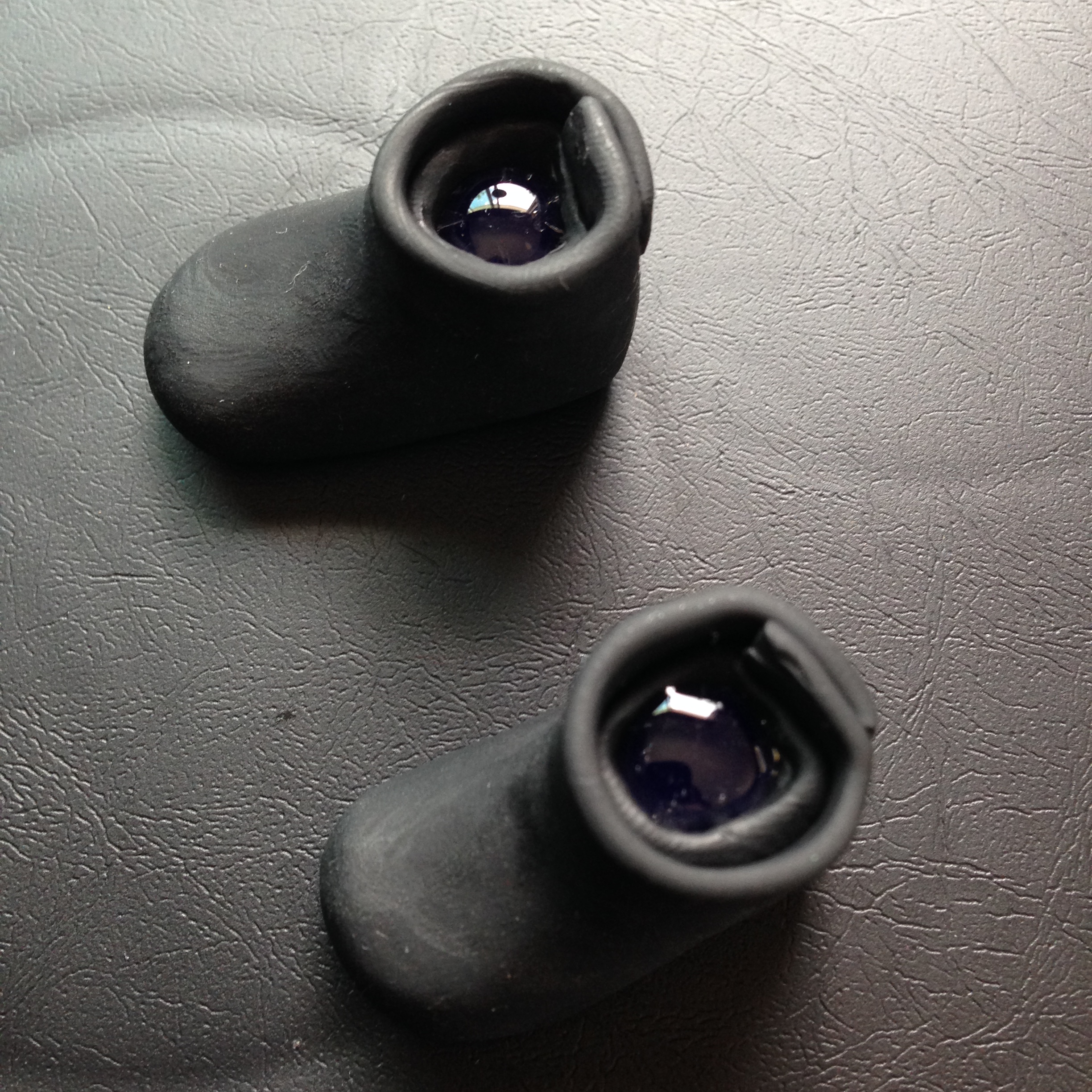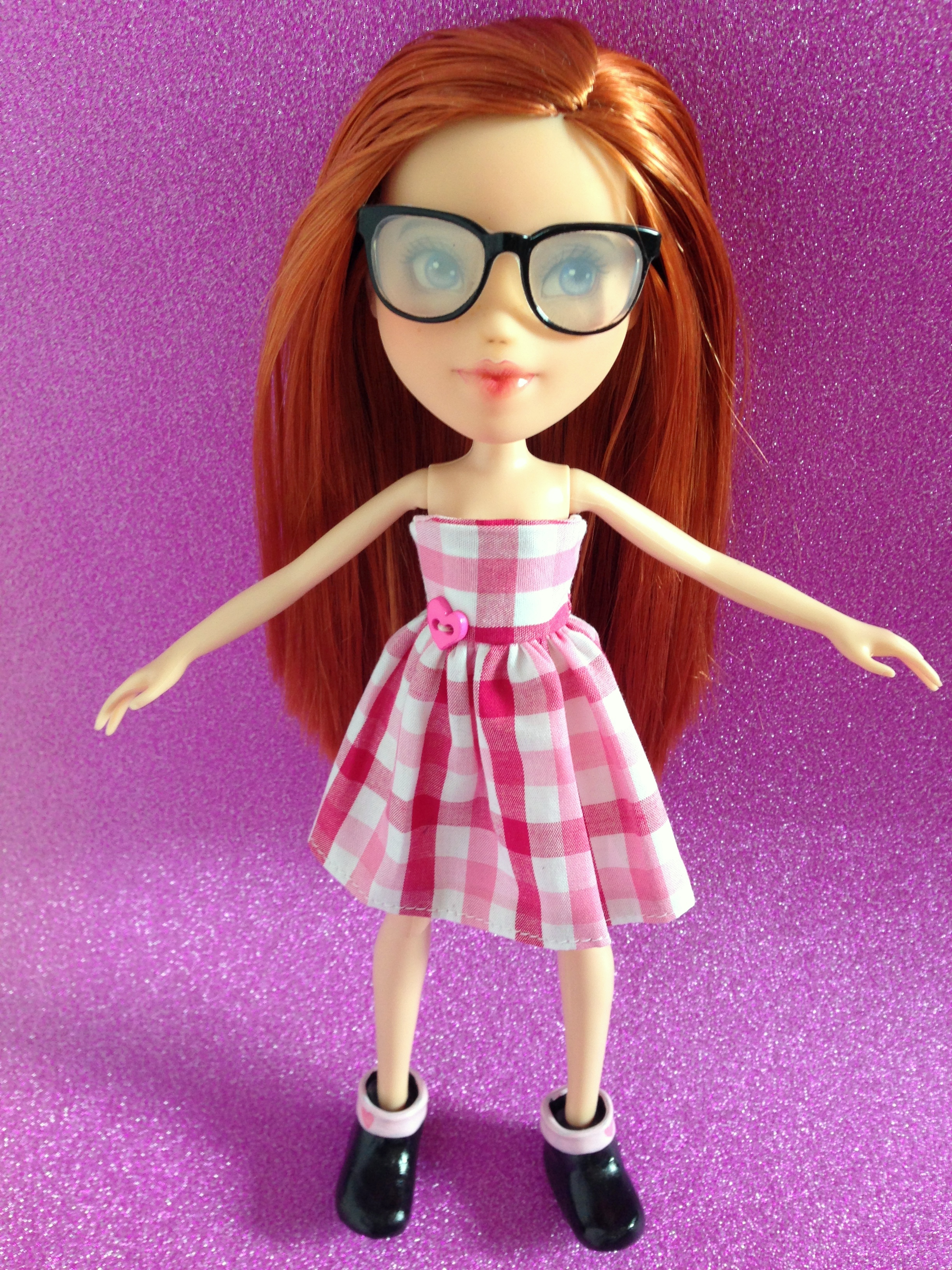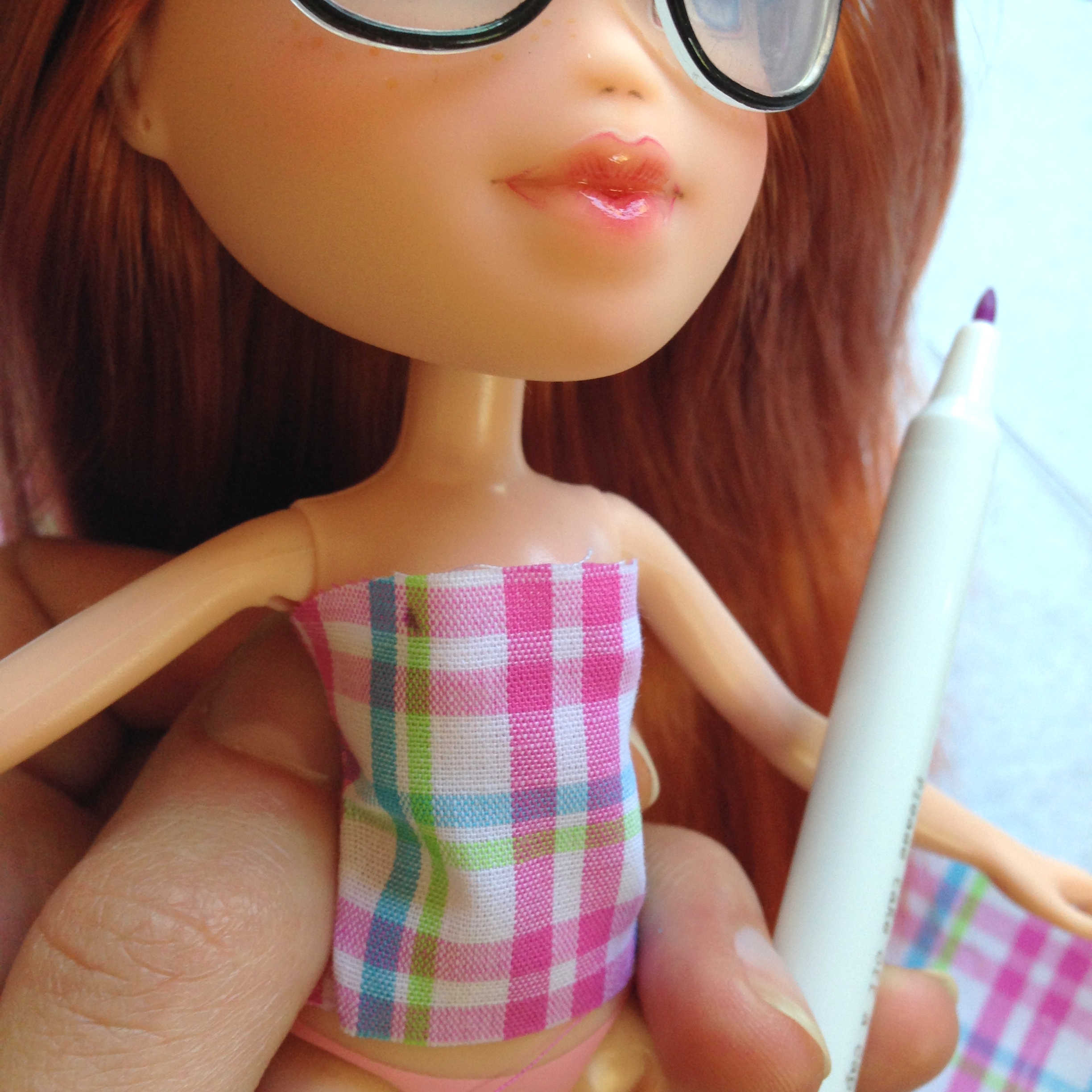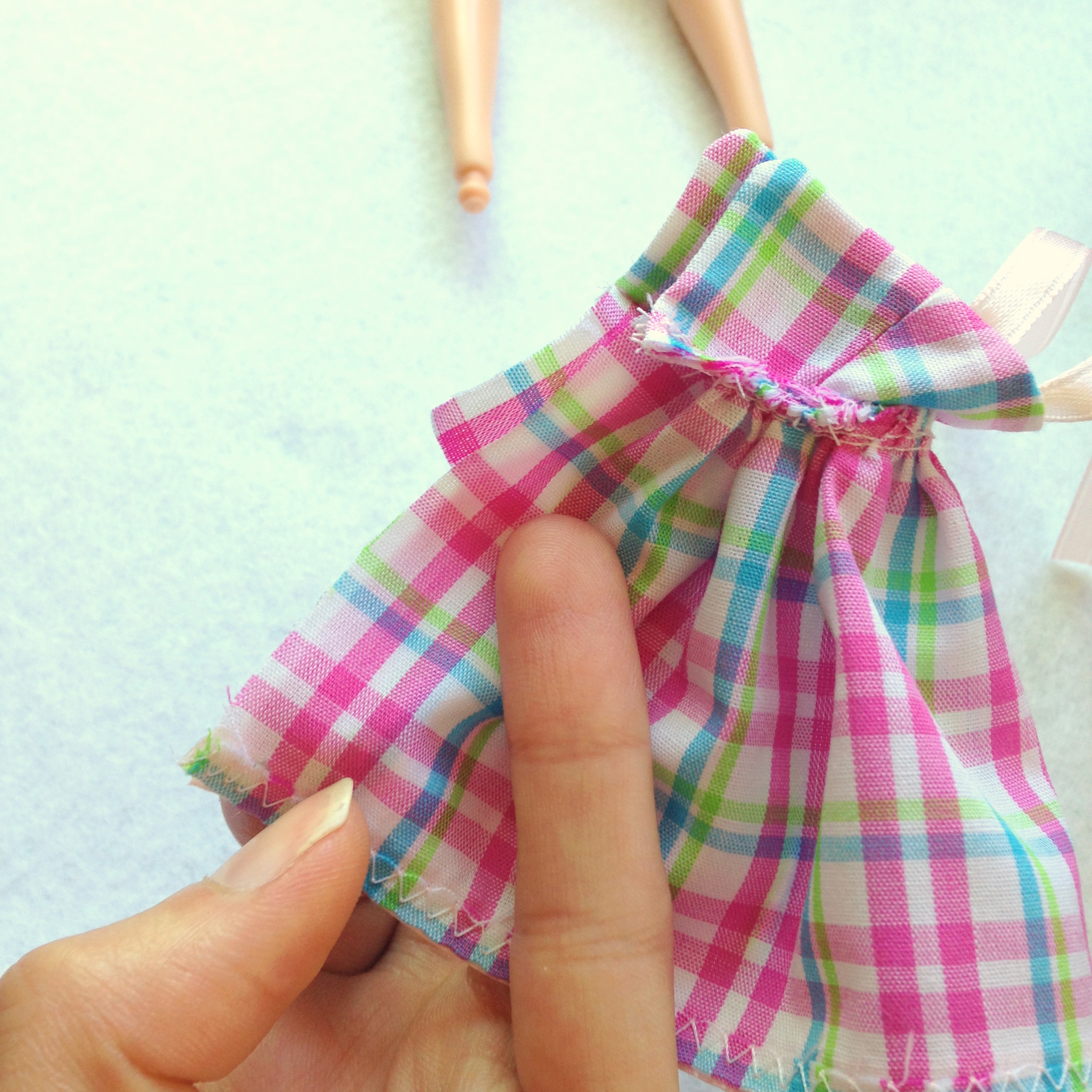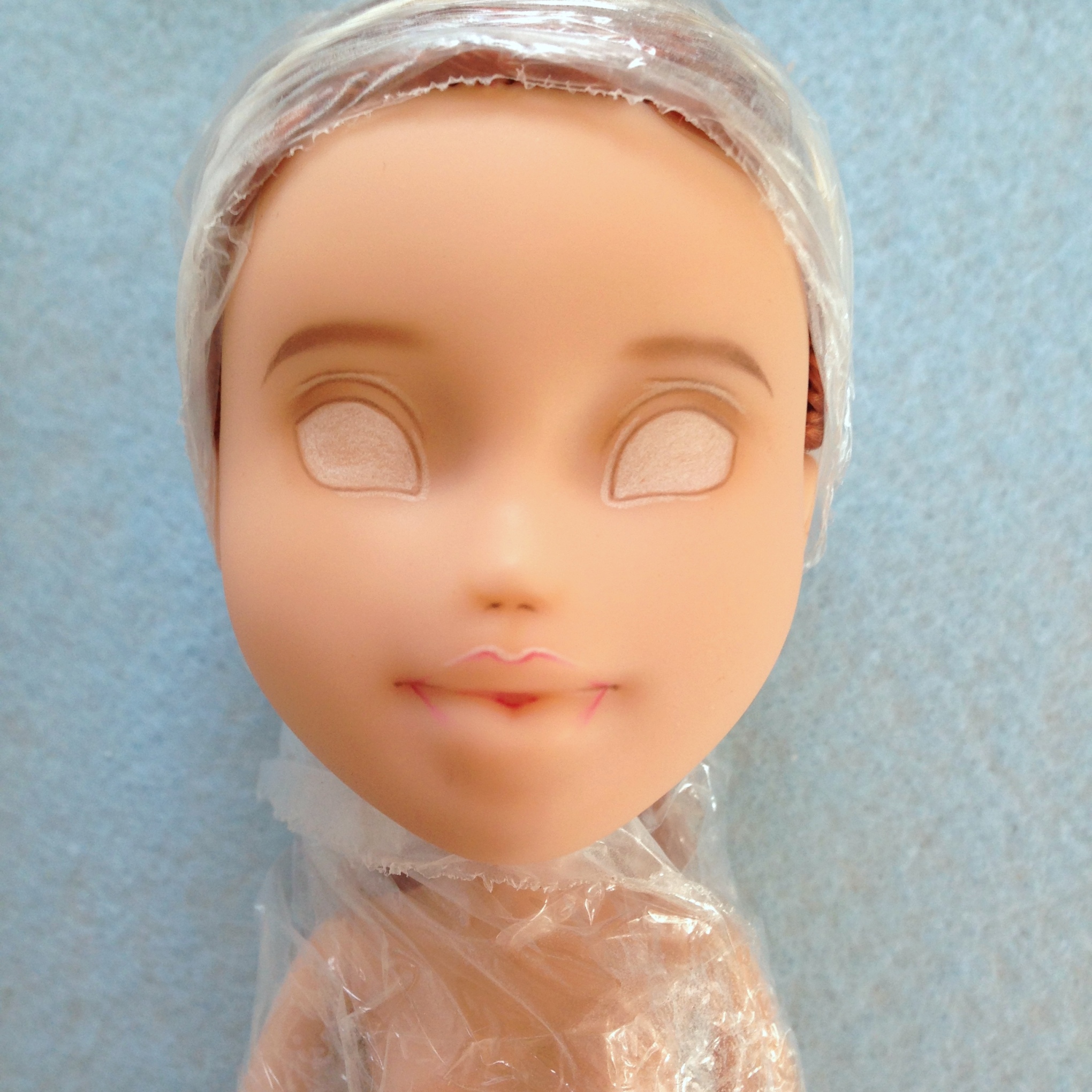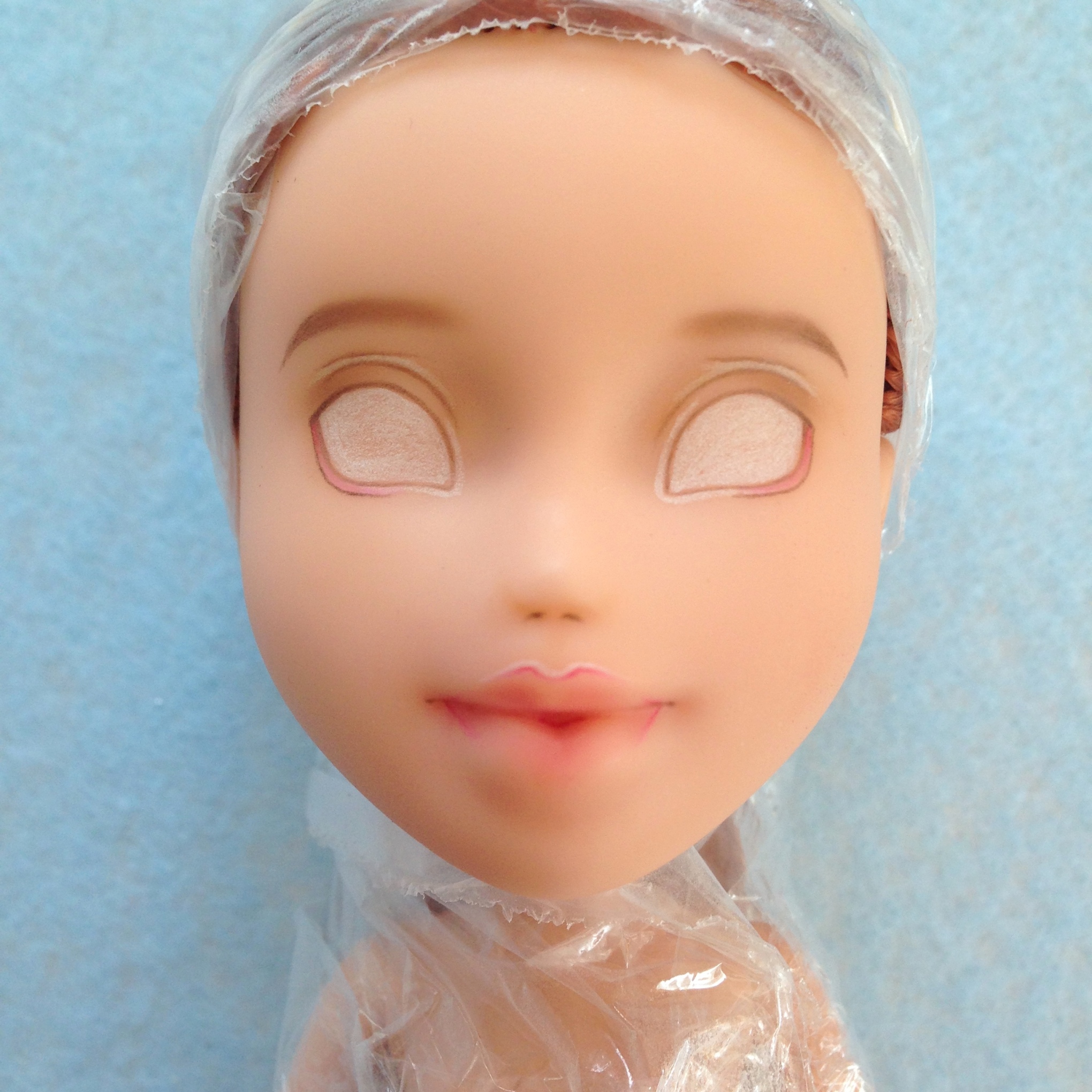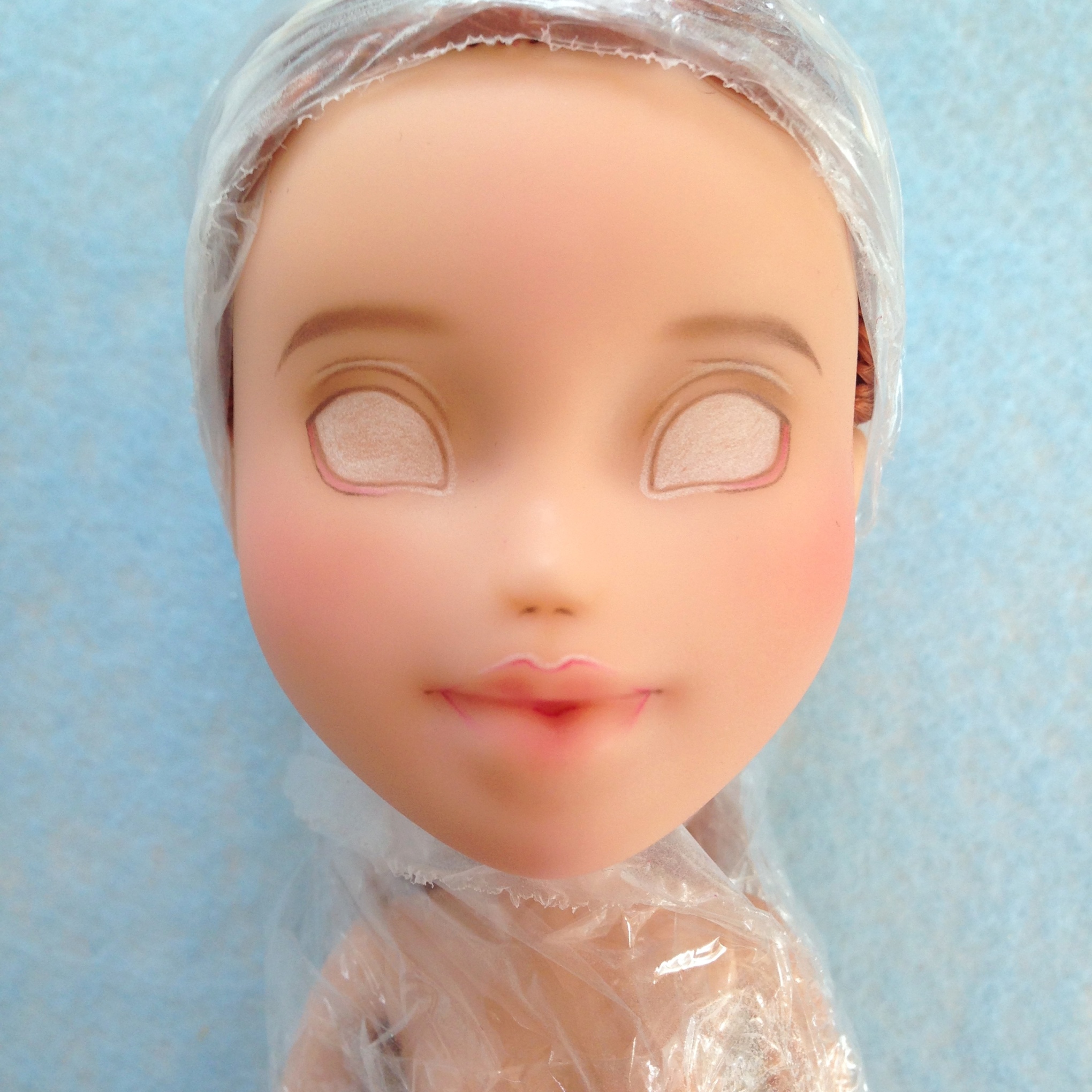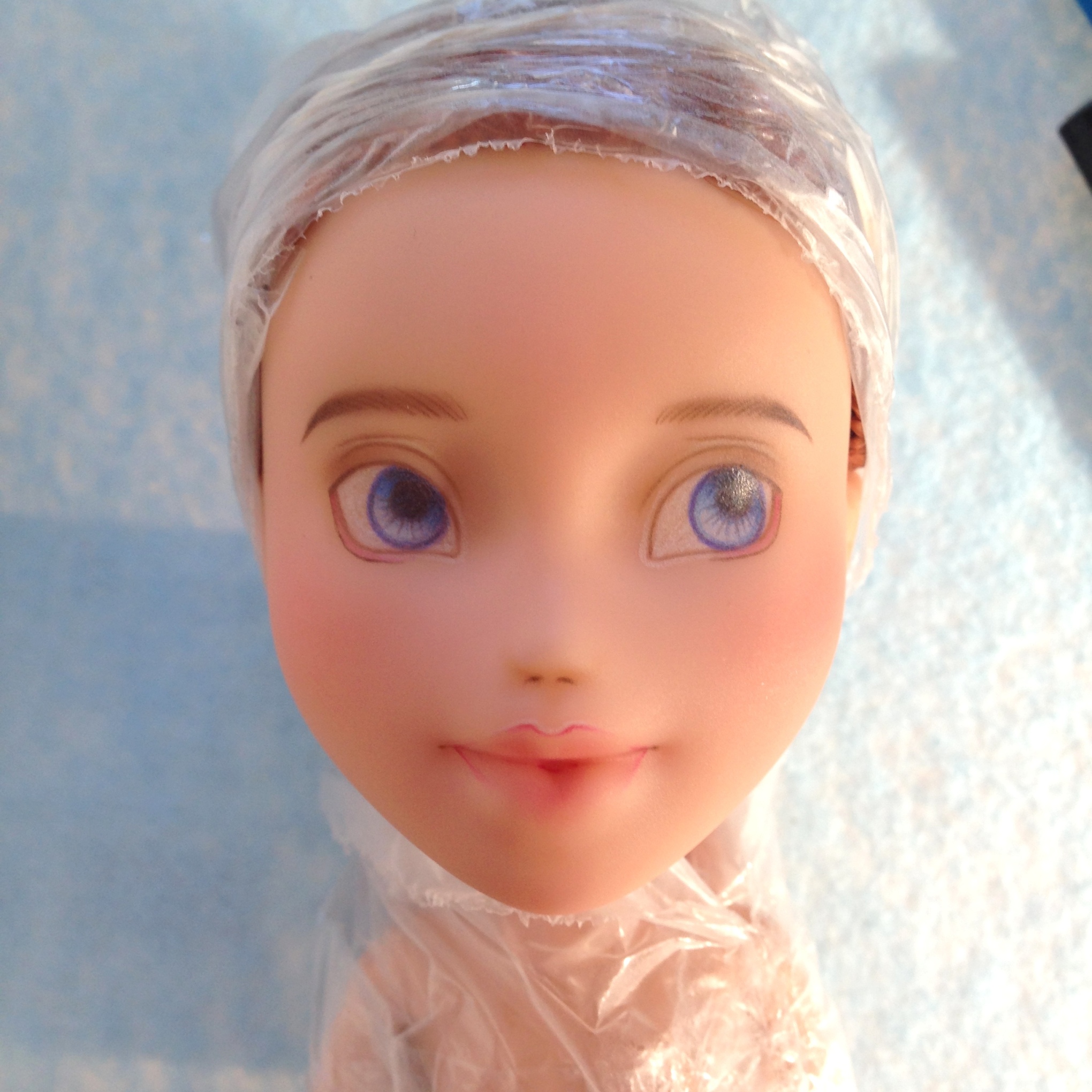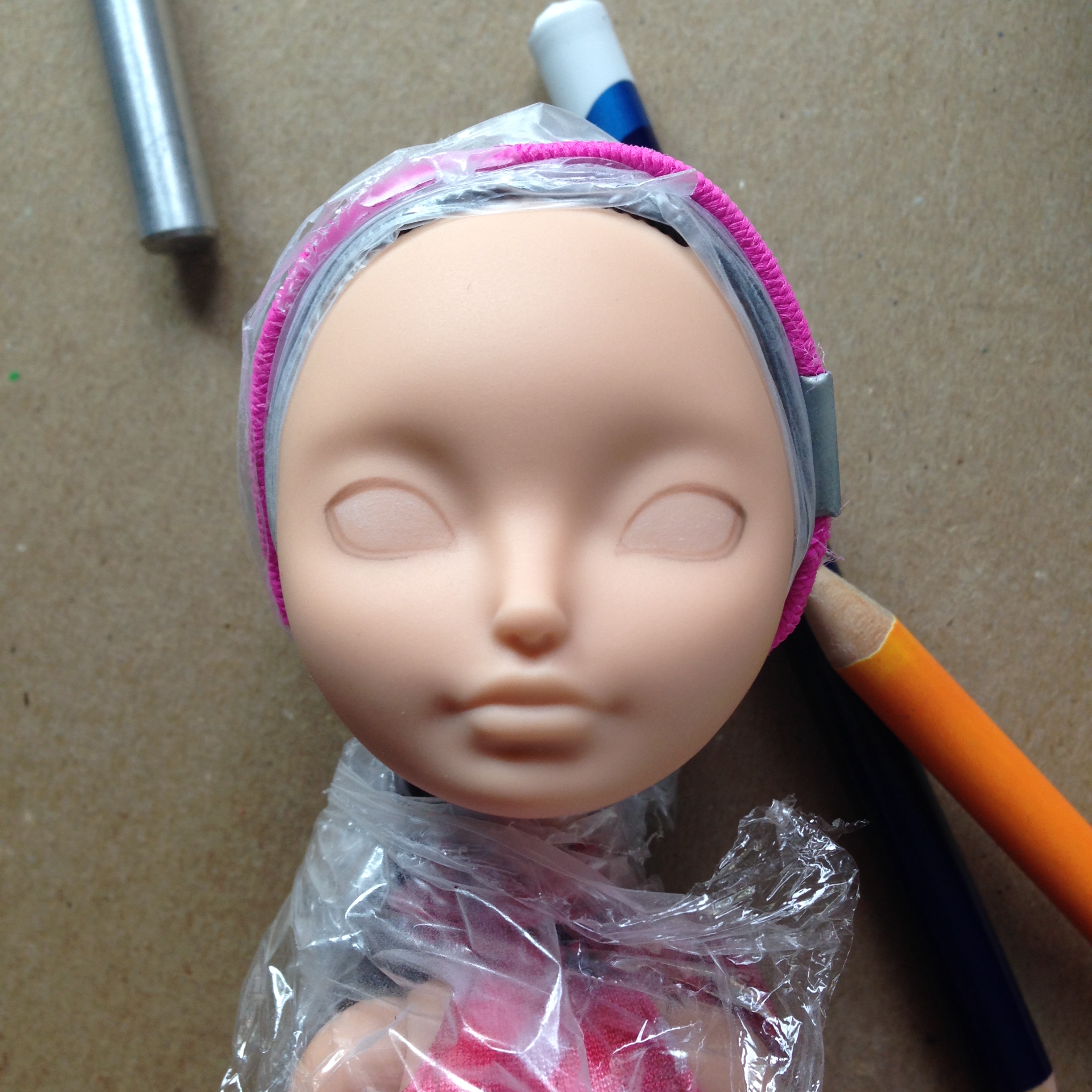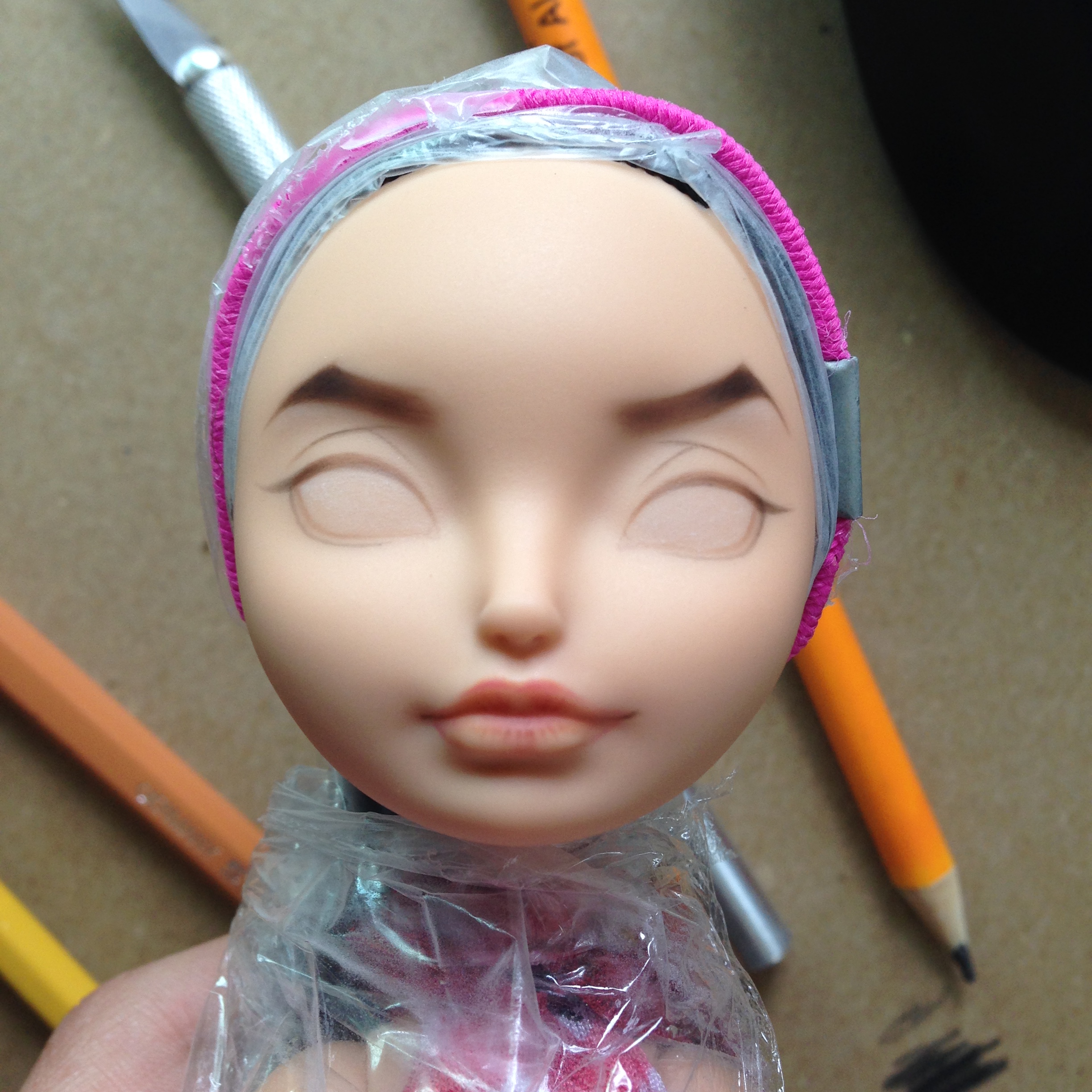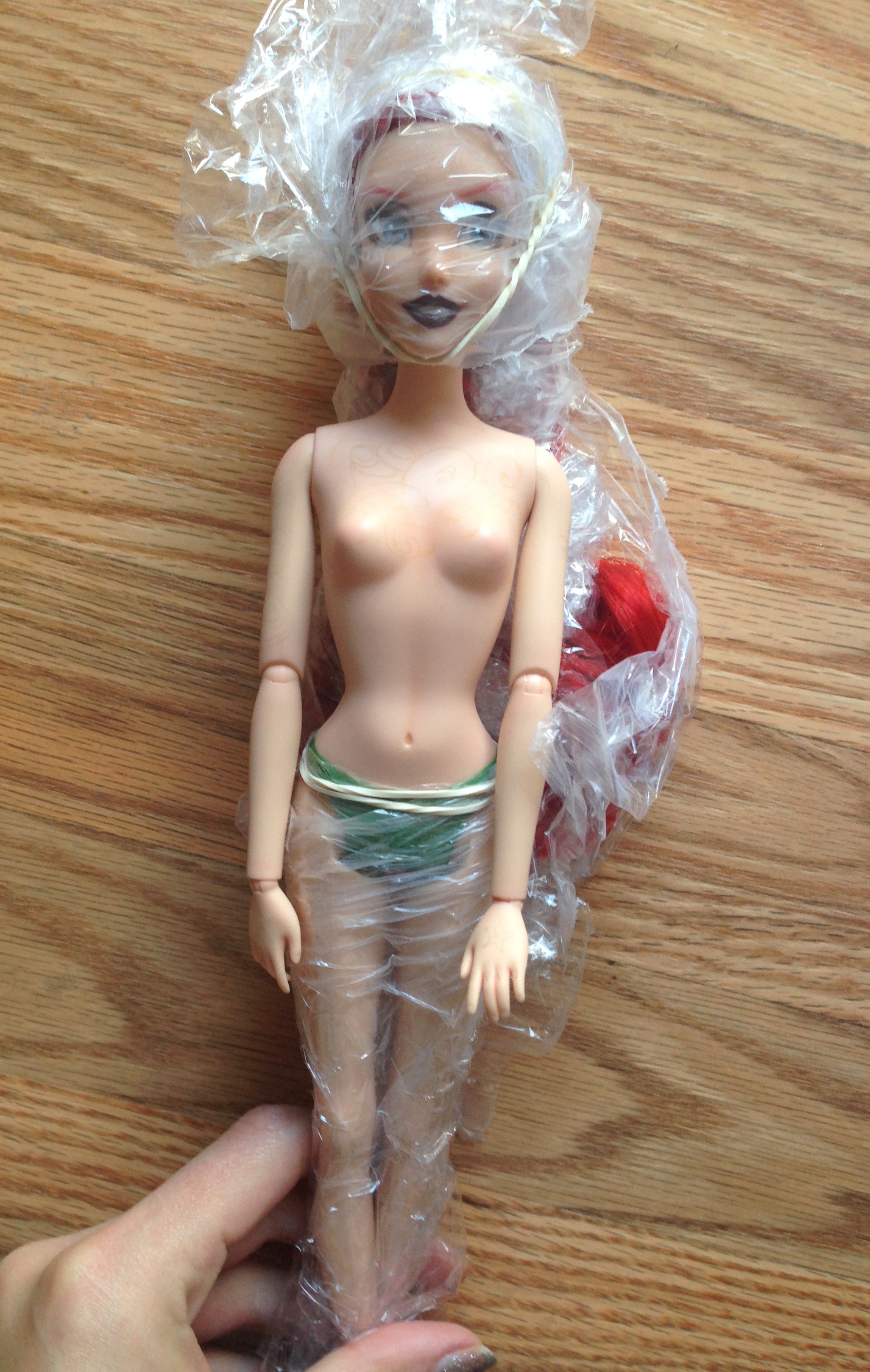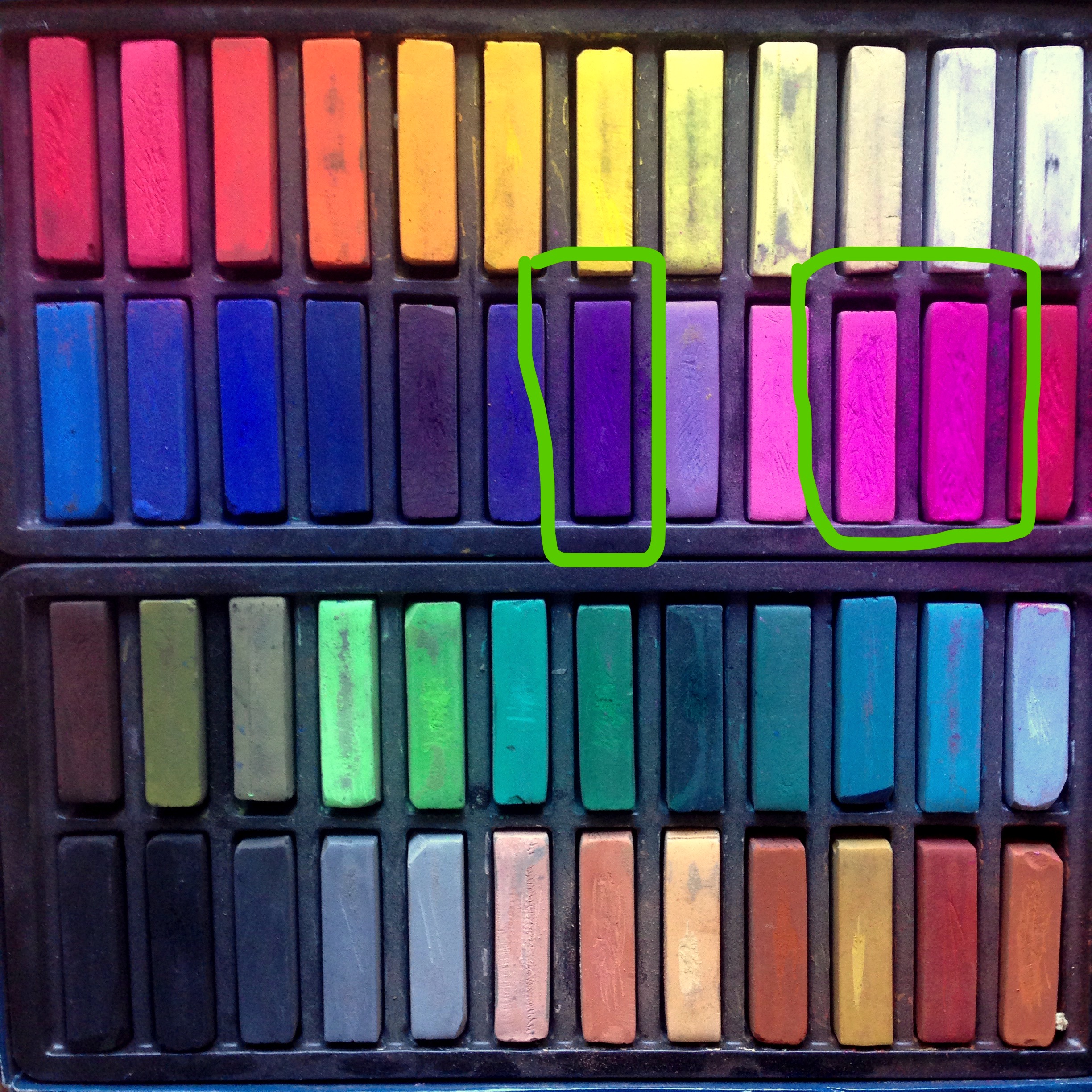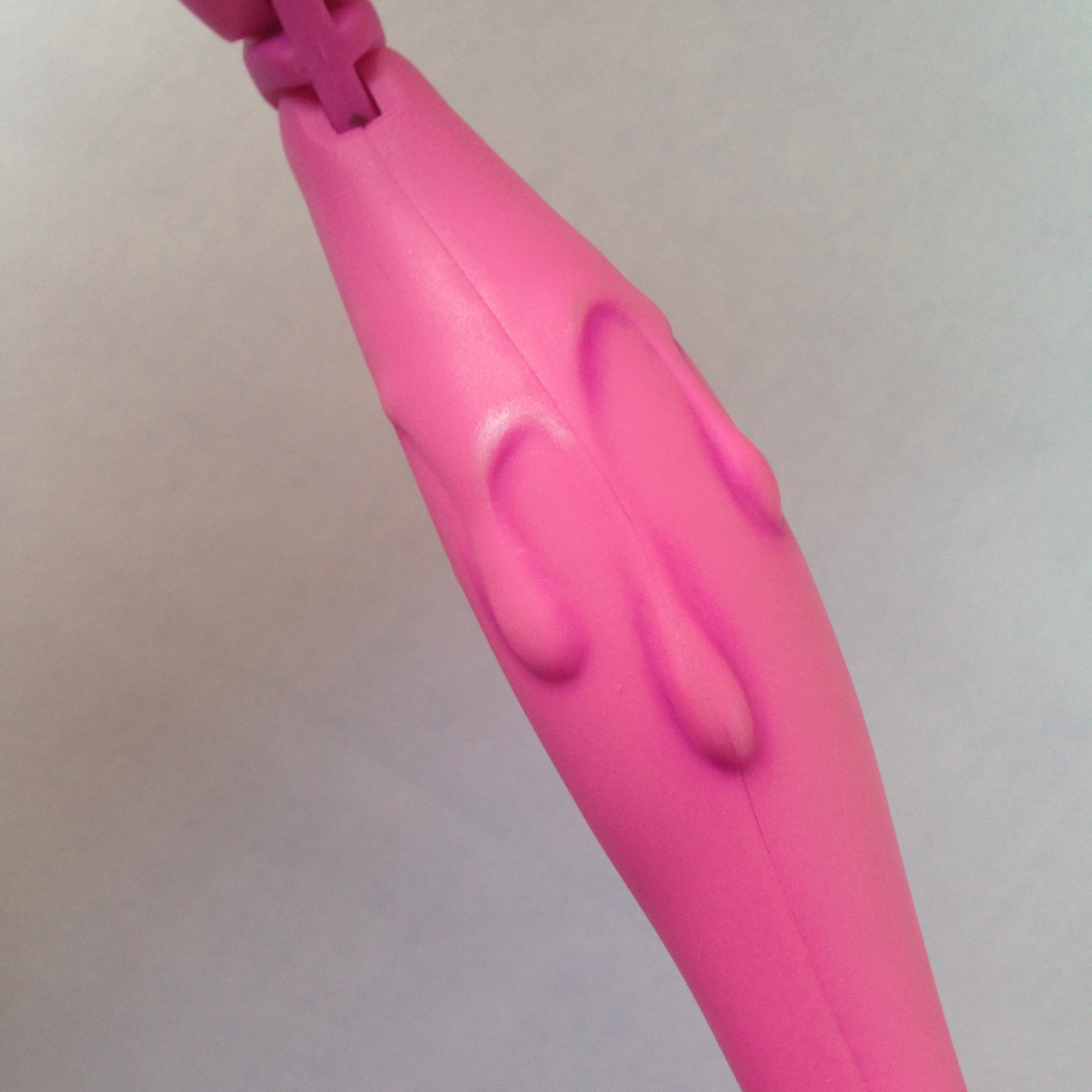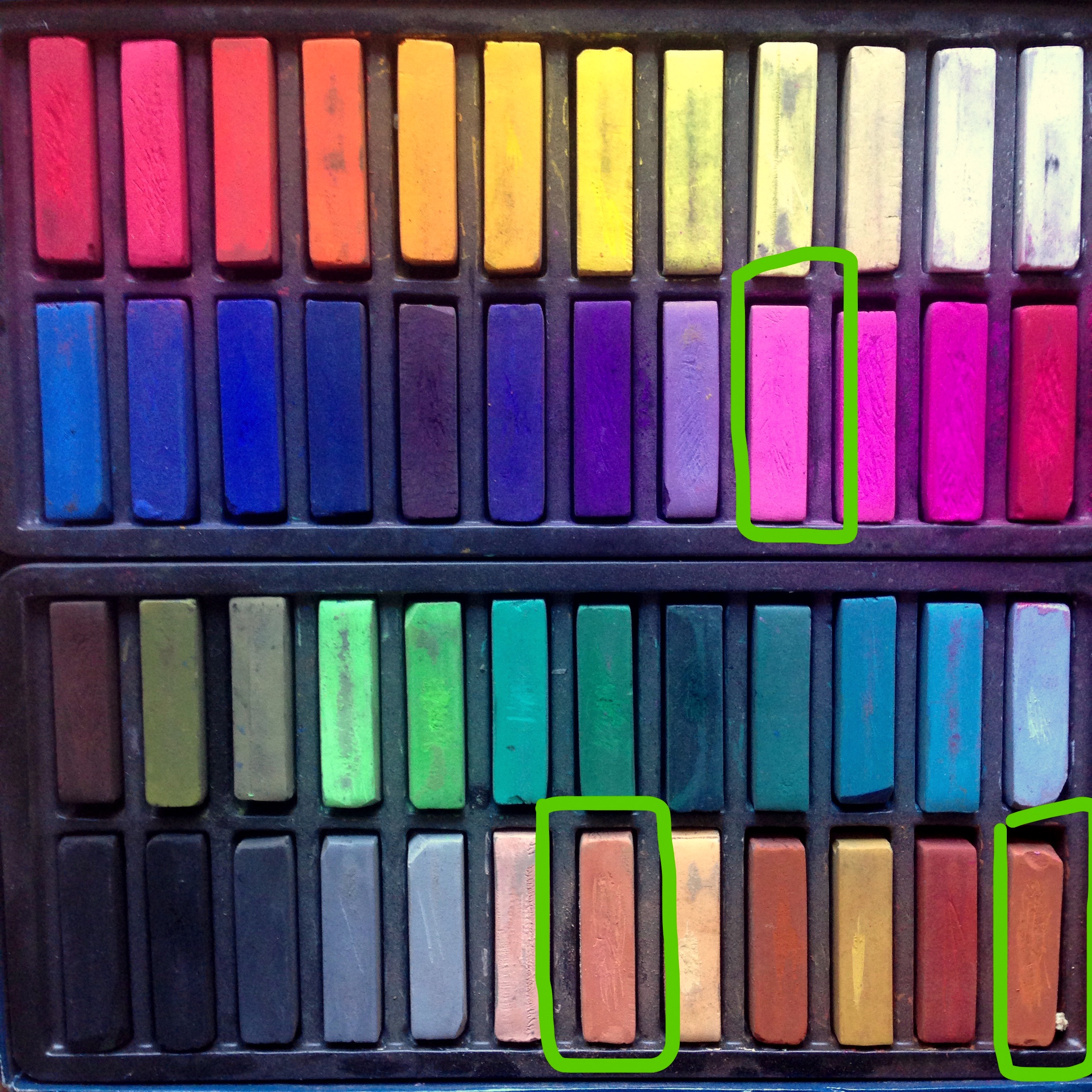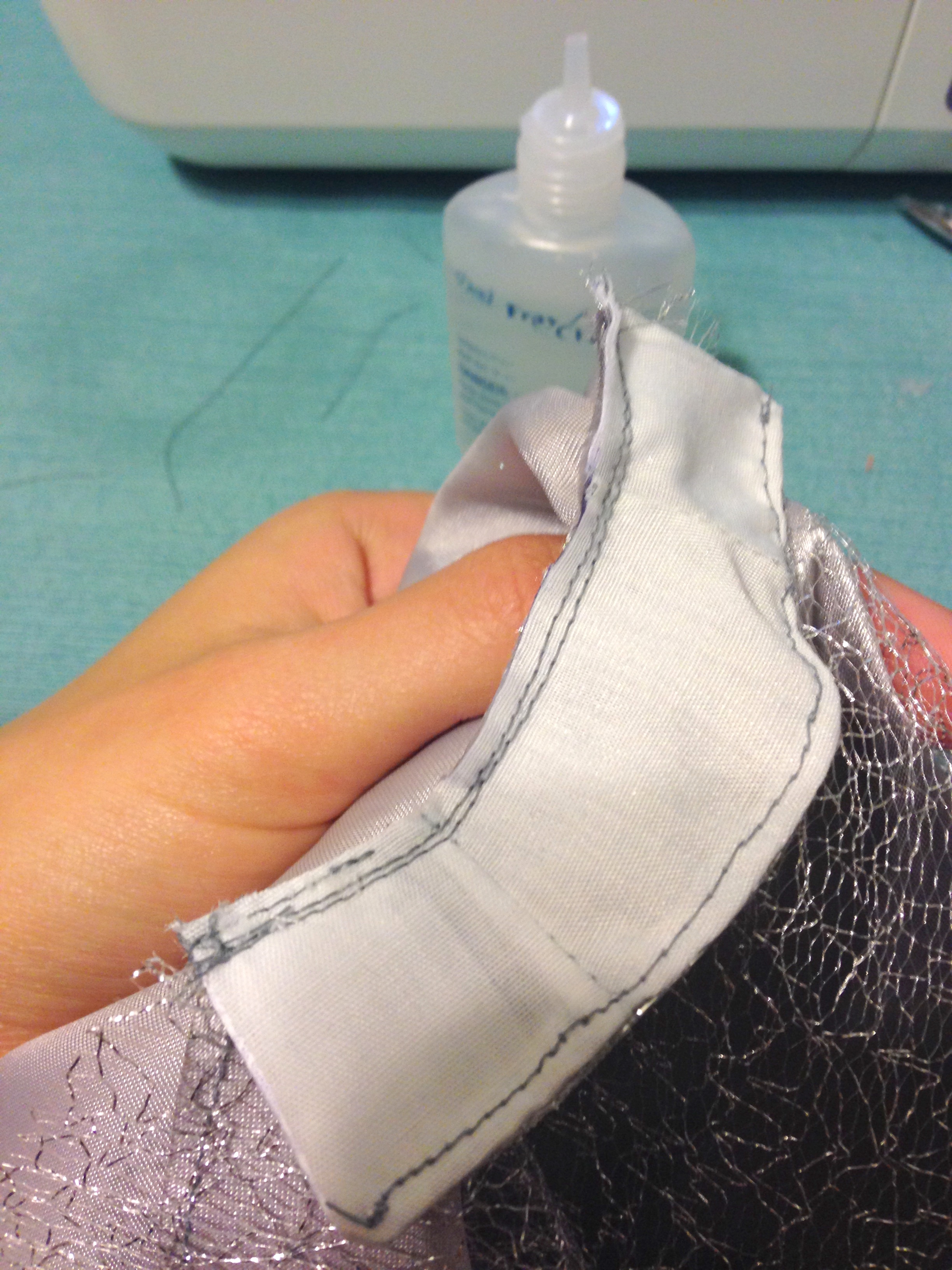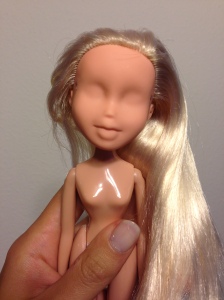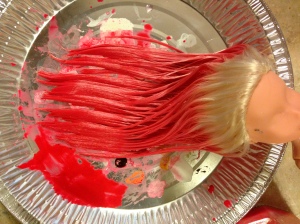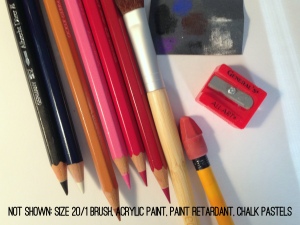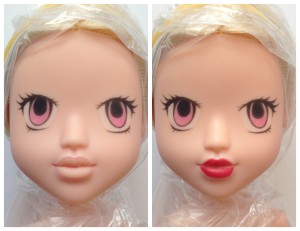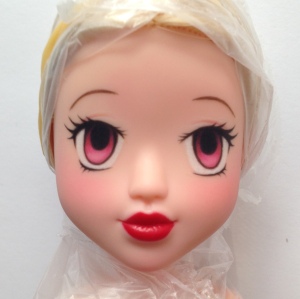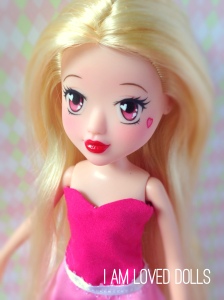Are you interested in repainting or customizing dolls, but aren’t sure what materials are the absolute essential ones to start with? I recently had a friend ask me about how to get into repainting dolls, but she saw my art desk (a picture) and balked at all the sh*t stuff strewn across it. I’ve been customizing for years, so I’ve accrued quite the collection of materials, but if you’re just getting started and are on a budget, here is my list of absolute, bare-minimum, must-have, super-essential stuff.
(Also, yes I know it’s been three years since I’ve posted anything on here. I’m still alive).
Disclaimer: this is a list of materials for the type of repainting or faceup that I most commonly do. I use watercolor pencils and chalk pastels for most of the colors/lines on the doll. I don’t use acrylic paint very often, although it is possible to repaint a doll using only acrylic paints and a bit of pastel for blush. If that’s your style, though, this materials list won’t be as helpful. Here’s a couple pictures of repaints using the watercolor pencil/chalk pastel method:
Ok. Below is the list itself if you need something for easy reference. I would recommend reading past “The List” to read about some of my notes on brands/type of materials to purchase (and some photo examples of what I’m talking about in the list).
The List – 22 Essentials of Doll Repainting
- Watercolor Pencils
- Black
- White
- Medium Brown
- Dark Brown
- Red
- Light (green/purple/blue – whatever eye color you want to draw, unless you want to stick w/ brown eyes, in which case you already have that color)
- Dark (green/purple/blue – the dark version of whatever eye color you want to draw)
- Chalk Pastels (you might as well just buy a set of 24, see below in chalk pastel section for notes, but these are your bare-minimum colors that should be included in any set you buy:)
- Pink (go for a warm pink that has a bit of orange in it – this is for blush and you want something natural)
- Black
- Dark Brown
- Light Brown
- A color for lips (this will depend on the skin color of your doll. A reddish-pink is fine for lighter-skinned dolls, and a reddish-orange or reddish-brown is fine for darker-skinned dolls. You could also just use the pink from above that was meant for blushing the cheeks).
- Mr. Super Clear – Matt/Flat by Mr. Hobby (Mr. Hobby is the brand, Mr. Super Clear Matt is the name of the product)
- Gloss Varnish
- White Acrylic Paint
- Tools
- Small, stiff flat brush (I mean really small)
- Medium fluffy brush (this is for blushing cheeks, mine is an eyeshadow brush)
- Small round brush (cheap, used to apply the varnish/gloss to eyes and lips)
- Good pencil sharpener
- Toothpick
- Eraser
Ok, that’s the list! That’s all you need.
It seems like a lot.
Won’t lie – this isn’t really the hobby that’s easy to “just try out and see if you like it” because it requires some specialty art materials. I think it’s reasonable to expect to put $50 – $60 into an initial set of supplies for repainting a doll, depending on how expensive your brushes are. For more details on the brands and where to find each of the above items, read on.
Watercolor Pencils
The bad news: you have to buy the nice fancy artist ones from the art store. The good news: you don’t use very many and it takes a looong time to use up a pencil.
Using “The List” from above, below is a photo of the pencils (from my collection) that are the foundation for ALL of my repaints (except for the green, which is just an example of the light/dark colors you want for eyes – they can be replaced with any color you like).
What to get: look for watercolors pencils sold individually in the fine art section of your local art store. Watercolor pencils are NOT the same thing as colored pencils, and both are often sold individually near each other, so make sure you’re selecting from watercolor pencils and not color pencils.
The reason watercolor pencils, and high-quality ones, are so necessary is that it can be hard to build up vibrant colors on doll heads made from soft vinyl plastic (like a Barbie head). Watercolor pencils have a higher concentration of pigment in their “lead,” and they do not contain wax, unlike colored pencils. Lower quality watercolor pencils do not have the intensity of pigment you will want for repainting dolls. Don’t bother settling for a cheap set, even if it seems like a good price. I recommend buying them individually, too, and not buying a set. I have exactly 27 watercolor pencils and only about ten are common colors that I would expect to be in a set of 24. The others are more unique colors suited to my personal palette preferences. I bought all of mine individually. I have been repainting for 6+ years now and I’ve gone through two white pencils and two black pencils, but all the others are the original ones I bought six years ago and most are not even 3/4 used up. The black/dark brown/medium brown/red in the above photo are the only ones more than halfway gone – the white was recently replaced.
Brands: look for Faber-Castell and Derwent brands. Both of these are pretty commonly at my local art store (based out of Denver, US). If you get Faber-Castell, you want to look for Albrecht Durer watercolor pencils. I think Faber-Castell has a slightly cheaper type of watercolor pencil called Goldfaber, and I’ve never tried this type.
If you get Derwent, I use their Inktense pencils which are basically watercolor pencils, and can be used like watercolor pencils but are technically a little bit firmer and brighter, according to Derwent. Honestly, I only have a few of the Inktense pencils because my art store was often out of the colors I wanted, but the select few I do have seem more pigmented and better for repainting than the Faber-Castell ones. So I would recommend Derwent Inktense over Faber-Castell Albrecht Durer.
I think both of these pencils sell individually for $2-3 each.
Where to buy them: when I say “go to your local art store” I mean an art store that sells these pencils individually and not in a set. If you have a Michaels or Hobby Lobby large enough to sell these individually, that’ll work. I prefer the local-local art store that is not a massive chain whenever I can, so I go to the fine art art store for my pencils (or I did, ages ago when I first got them).
Chalk Pastels
That’s the set I use.
Chalk pastels are often sold individually at fine art stores, BUT unlike watercolor pencils, it will likely be more economical to just buy a set of 24. The pastel colors in “The List” are the bare minimum colors you want to be included in your set. If you were to buy those colors individually it would probably run you about $2.50 per pastel stick (they’re 3-4 inches long), OR you could just buy a set of 24 half sticks for about $10-15 dollars.
What to buy: Buy THESE or something similar. That’s a link to Dick Blick (common art store in the US), specifically the Faber-Castell Goldfaber Studio Soft Pastel set of 24 half sticks. I use the same set with 48 colors (picture to the left), but the 24 color set has the colors that you need (and I don’t use most of the 48 set for repainting dolls). The 24 color set is about $10 right now on Dick Blick, but I’ve seen it for around $15 in art stores.
I’ve had this set of pastels for even longer than I’ve been customizing, because I used them in an art class back in middle school (that was a LONG time ago). I haven’t gone through any of the half sticks yet; they should last you years and years.
There are probably cheaper sets of these chalk pastels, or soft pastels, out there. I haven’t used those, so I can’t say whether or not they work. Faber-Castell is a pretty high-quality brand in general, so I would expect them to be more pigmented than cheaper brands. And more pigment is what you want.
If you’re at the art store, and/or reading about doll customization online, you might hear of something called Pan Pastels. These are soft pastels that come in a shallow disc and cost the approximate value of your first-born child, and I don’t know why anyone would pay that much for pastels for doll faces. No offense to all the great artists who do, I just don’t think it’s a necessity for a beginner at this. Or for me.
Mr. Super Clear
Here is a picture of what you’re looking for:
This is used to prime the surface of the doll’s head for repainting, to help build up pigment, and to seal the pigment in once it’s on the doll’s face.
MSC is different from many other sealant options out there: it has a tooth to it, or a slightly rough texture similar to paper. Other sealants are normally smooth and without texture, which means there is nothing for the watercolor pencil pigment to stick to. So yes, you really do need MSC and not other sealants.
What to buy: Mr. Super Clear is normally referred to as MSC in the doll repainting world. It comes in “Flat” OR “Matt” depending on how old the can is. Most cans I find now are “Matt.” To be clear, Flat and Matt are the same product, “Flat” was just an older label that was phased out several years ago and replaced with Matt (WHY is it not “matte?!”).
MSC Matt also comes in two forms – UV Cut and the normal one (like the can above). The UV Cut MSC is normally a dollar or so more expensive, and has a little red “UV-Cut!” text on the front of the can. It makes the pigment under the sealant more UV-resistant, which is good, but I don’t think UV Cut is necessary for a beginner if you want to save a dollar or two and just get the normal stuff.
Just DON’T get MSC “Gloss.” It’s, well…a gloss. And it will make your dolls look creepy and shiny all over.
Where to buy: I use to buy MSC on Ebay, mostly. It would be about $15 per can (sometimes $10 with $5 shipping) and was always available.
Currently I buy MSC at my local hobby store, which is, in fact, different from my local art store and my local craft store. A lot of hobby stores will carry Mr. Hobby products, MSC Matt included, because they’re used a lot in the miniature modeling world. A hobby store is the kind of store that might sell gaming miniatures, tabletop games, RC cars, model planes, stuff for miniature trains/railroad terrain….you know, nerdy stuff that like.
What about other, cheaper options: MSC Matt is kind of the gold standard for doll repaints. Just get it. It’s an aerosol and has to be sprayed outside and all that, but from the research I’ve done nothing else out there really seems to get equal results. The can should last you a while – I get a LOT of repaints out of each can. It’s worth getting it in the beginning, because if you don’t, you’ll probably get frustrated 2-3 repaints in and end up buying the MSC anyway.
Gloss Varnish
There’s mine. It’s a very old bottle from my mom, actually.
This is used to brush over the eyes and lips of the doll to make them a bit glossy and more realistic.
What to buy: look for a small (1-2 oz) bottle of Gloss Varnish for crafts. There are different types of gloss. You’ll often see a high gloss, gloss, semi-gloss, satin, and matte finish options in the varnish section of the craft/art store. Personally, I prefer semi-gloss and satin finishes, which are less glossy than high gloss/gloss finishes. My bottle is a satin gloss, and if I put a few layers on I can get a high-gloss, but I often don’t want to.
The varnish is only used to make the eyes and lips glossy, and if you don’t want that, then you can skip this material entirely.
Where to buy: a craft store like Joanns, Michaels, or even the craft section of a Walmart should carry these little 2oz bottles. Some fine art stores carry them too, but it’s a little more rare (at least they’re not sold at mine. You can buy a gallon of gloss varnish, but not 2 oz). If you don’t live in the US or have no idea what Michaels or Joanns is, just go to you local craft store and you should be able to find some.
White Acrylic Paint
This is used to make the little eye reflection dots, or catch lights, in the doll’s eyes.
That’s mine.
What to buy: any 2 ounce bottle of white acrylic paint. It should be less than $3.50. You’ll need to water this down before applying it, so the fact that it’s the thin runny acrylic paint is fine.
Where to buy: craft store like Joanns and Michaels have tons of these, Walmart has them too, even Dollar Stores. You don’t need anything fancy.
Tools
These are the tools you use to apply pastels, gloss varnish, and catch lights to the doll’s face.
From “The List” here are my three most-necessary brushes (and a toothpick).
Note that none of these brushes need to be/should be expensive. You could get them at the dollar store if you wanted. This isn’t where you need to invest your money.
Small stiff flat brush: To the left, you can see the “small stiff flat brush” on the very left. It’s black, size 10/0 flat in a random brand from a random art store (keep in mind that brush sizes are not standardized so the size examples in this article might not be helpful). The brand really isn’t important, and you should go with a cheaper brush over an expensive one. What’s important is that it be a flat brush, small enough that you could imagine applying eyeshadow to a Barbie with it, and have short fibers (this is what will make it a bit stiffer). This brush is use to apply pastels to the eyes (eyelids, really), brows, and lips.
Medium fluffy brush: Above, you can see this brush in the middle. It’s actually an eyeshadow brush from the grocery store (brand is EcoTools, not sure of the size). This brush is used to apply pastels to the cheeks, so get a size that you think would be good for that. The brush I use is very soft, which is great at getting very even blends of blush and shading – you want a soft fluffy one for sure.
Small round brush: Above, you can see this brush on the right (it’s the one that is not a toothpick). Honestly, I just grabbed a random brush from my collection of tiny brushes to use as an example. This brush is used to apply the varnish to the doll’s eyes and lips. It shouldn’t be expensive, because the varnish will likely mess up the fibers on the brush anyway, and you might have to replace it more often. The one I use right now is size 2/0 from Artists Loft, the cheap Michaels brand.
Toothpick: You want a toothpick with a pointed end. This is for applying the little white dot for a catch light inside the doll’s eyes. It could help to even file down the end of the toothpick using a nail file or emery board to make it smaller. Depends on how small/large you want your eye dots. Keep in mind that you can always make them larger, but you can’t go smaller than the end of your toothpick.
Pencil sharpener: You want a pretty good sharpener to keep your watercolor pencils sharp (they need to be REALLY sharp to get the thin lines for eyelashes and such). I use this one: LINK
It’s a little more expensive (around $7-9 depending on where you buy it) but the blade is very sharp and I don’t have to replace it often. Look around at the art store, or the craft store, for a sharpener that isn’t the “bottom shelf” super cheap kind. Those blade are not as high-quality and they will get duller faster, which could end in you breaking the tips of your pencils while sharpening. A sign that your sharpener may not be sharp enough is if it’s breaking off the lead of your pencils.
So you don’t have to get the fancy one I use, just don’t get the super super cheap one either.
Eraser: I actually almost forgot this one! A nice eraser will make your life as a beginner repainter MUCH easier. I use a very very small one meant for a .03 mechanical pencil. It’s the replaceable type, I just keep it out of the pencil and in my little area for tiny doll things.
I like this size because it’s very, very precise. You can use any type of firm eraser (for bigger areas I often use a normal pencil eraser) but you need to be able to get into the small areas of a face mold, so look for a pretty small one or one with a fine tip on it.
You can find these super tiny erasers for mechanical pencils in the art store, either in the pencil section or the architect/drafting section (if that exists in your store). They normally come in a tube of 5 or so.1
And that’s a wrap! Do you disagree with my list, or think it’s missing something? Let me know in a comment!

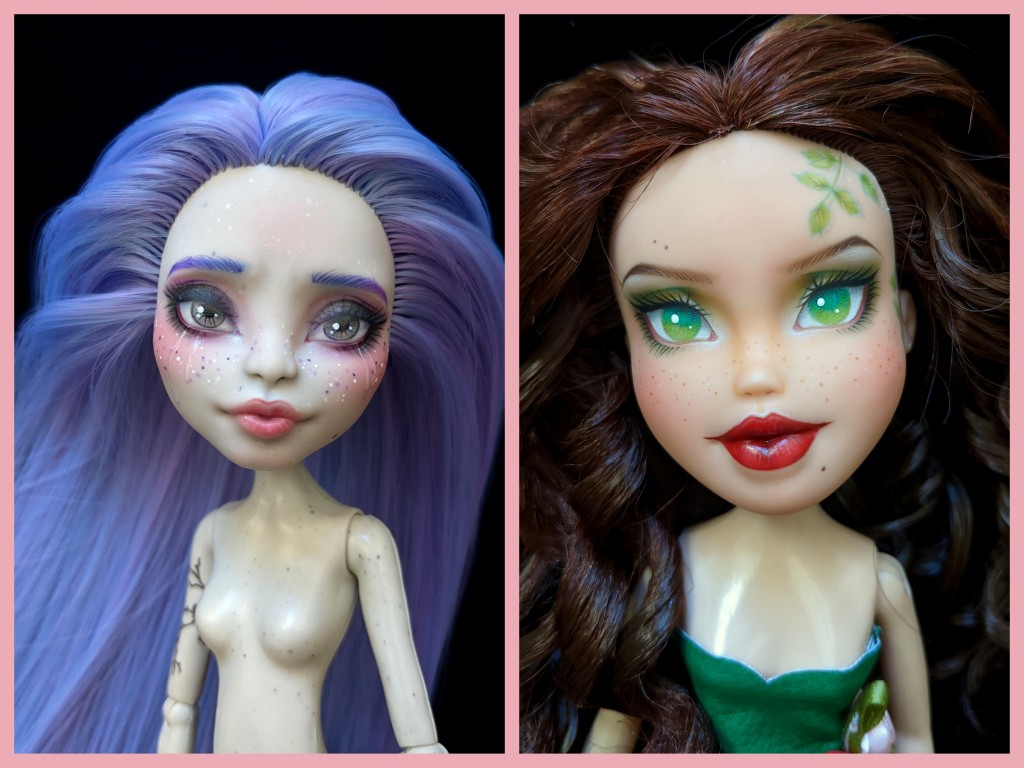









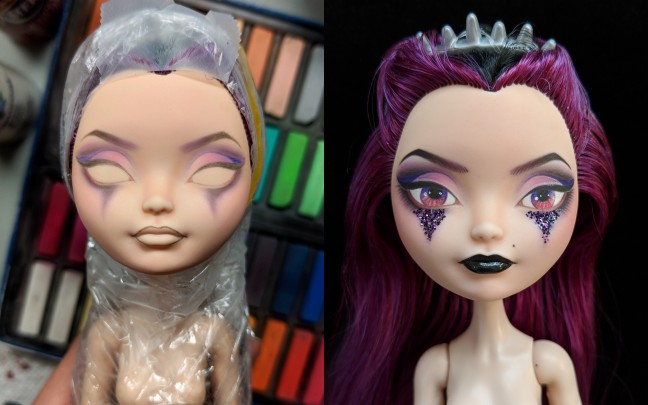




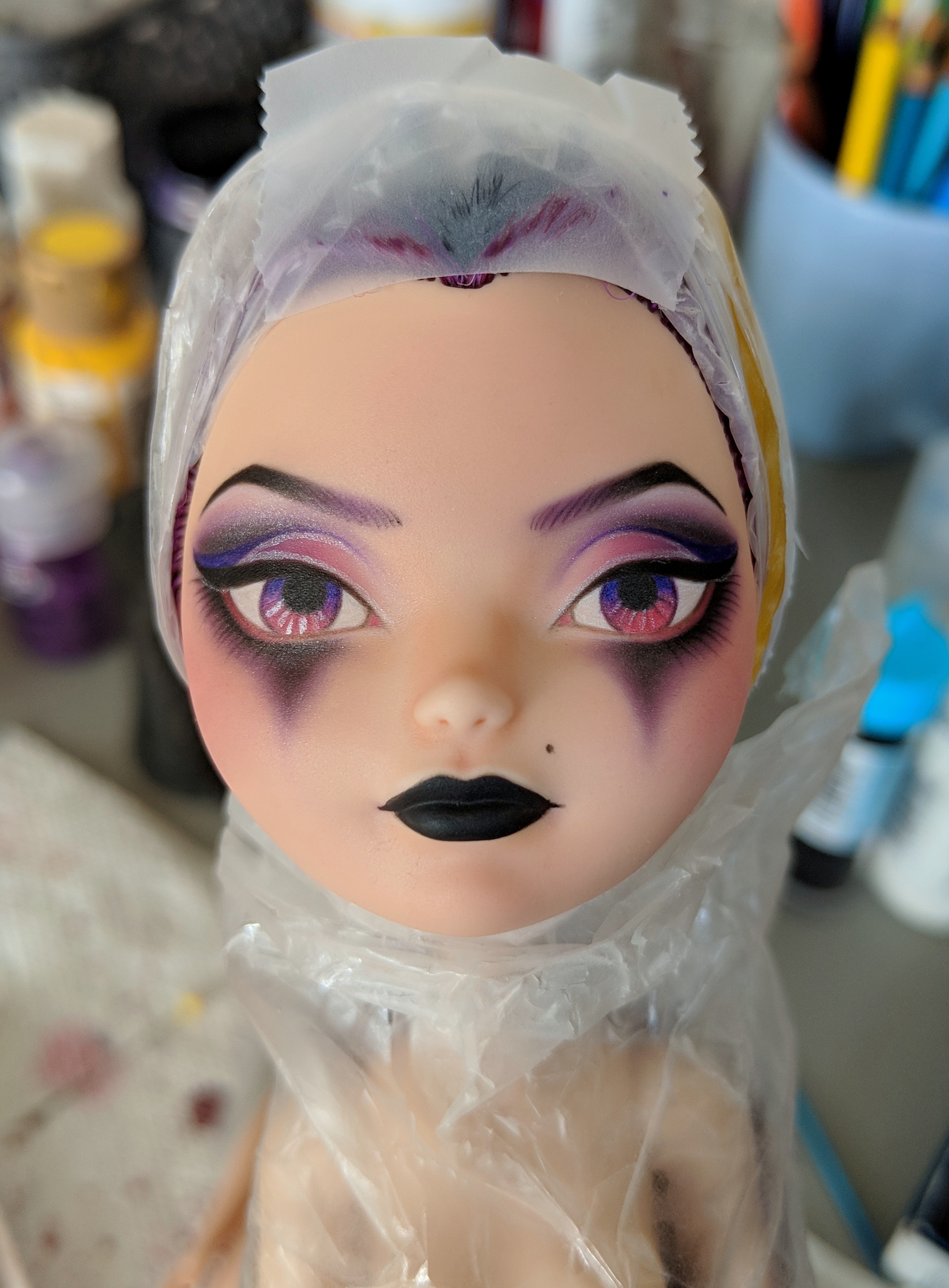

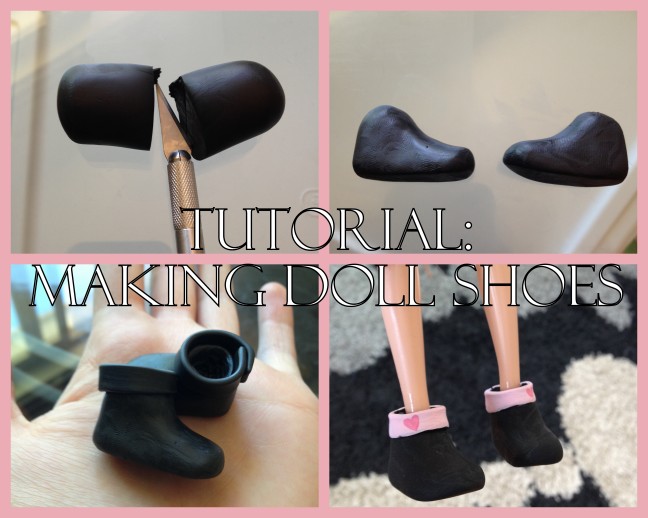














 First, you can just lick your finger and use that to smooth out the clay. I normally don’t do this. You can also dab your finger in baby powder and rub it on the clay, using the baby powder as a film between the clay and your fingers to prevent more prints from showing up as you smooth the old ones away. I don’t do this with boots because it’s a bit messy, and because it doesn’t work very well with dark colors (baby powder is white, after all).
First, you can just lick your finger and use that to smooth out the clay. I normally don’t do this. You can also dab your finger in baby powder and rub it on the clay, using the baby powder as a film between the clay and your fingers to prevent more prints from showing up as you smooth the old ones away. I don’t do this with boots because it’s a bit messy, and because it doesn’t work very well with dark colors (baby powder is white, after all).


